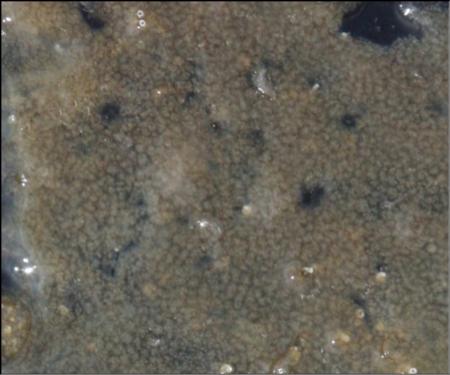Colonial Sea Squirt or Tunicate
-
Scientific Name
Diplosoma listerianum - Visit ITIS for full scientific classification.
-
Description
 Diplosoma listerianum. Photo by Carrie Culver © 2008 Regents, University of California.
Diplosoma listerianum. Photo by Carrie Culver © 2008 Regents, University of California.- Colonial tunicate ("sea squirt") with small, cylindrical-shaped individuals immersed in a communal structure.
- The colony forms flat, thin, mucous-covered sheets, up to 2 inches wide that grow on a variety of surfaces.
- Translucent appearance.
- Can be milky yellow, or greenish, with white or grey colored spots.
- Feed through incurrent siphons (tubular openings) that bring food particles in with the water current.
-
Habitat
- Subtidal marine environments.
- Attach to a variety of surfaces including rocks, shells, other marine animals, seaweeds, buoys, lines, woody debris, vessel hulls, etc.
-
Invasion Pathways and Distribution
- Spread by attaching to vessel hulls, from which larvae swim to settle on surfaces in marinas.
- Originally described from the English Channel.
- However, there are many similar species and it has a very broad global distribution, therefore the exact native origin is difficult to determine.
- It appears to be introduced along much of the North American coast, including California.
- See NEMESIS for distribution maps.
-
Life History
- Filter-feeder.
- Reproduces asexually by budding or sexually by releasing sperm and eggs into the water, where they unite to form swimming larvae.
-
Impacts
- Colony forms a dense aggregation on boat hulls.
- This fouling growth roughens the hull’s surface, creating friction or “drag” that slows sailboats and increases fuel consumption for powerboats.
- Tolerant of copper in antifouling paint.
-
References and Useful Links
For references by category and links to other useful AIS sites see our LEARN MORE page.

